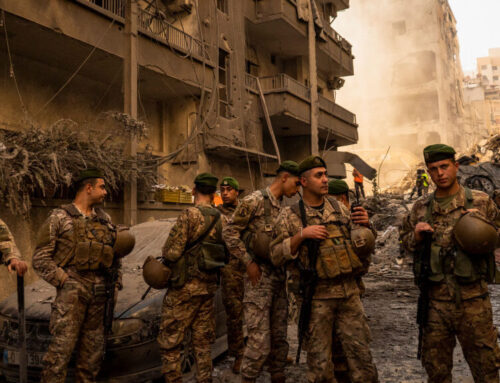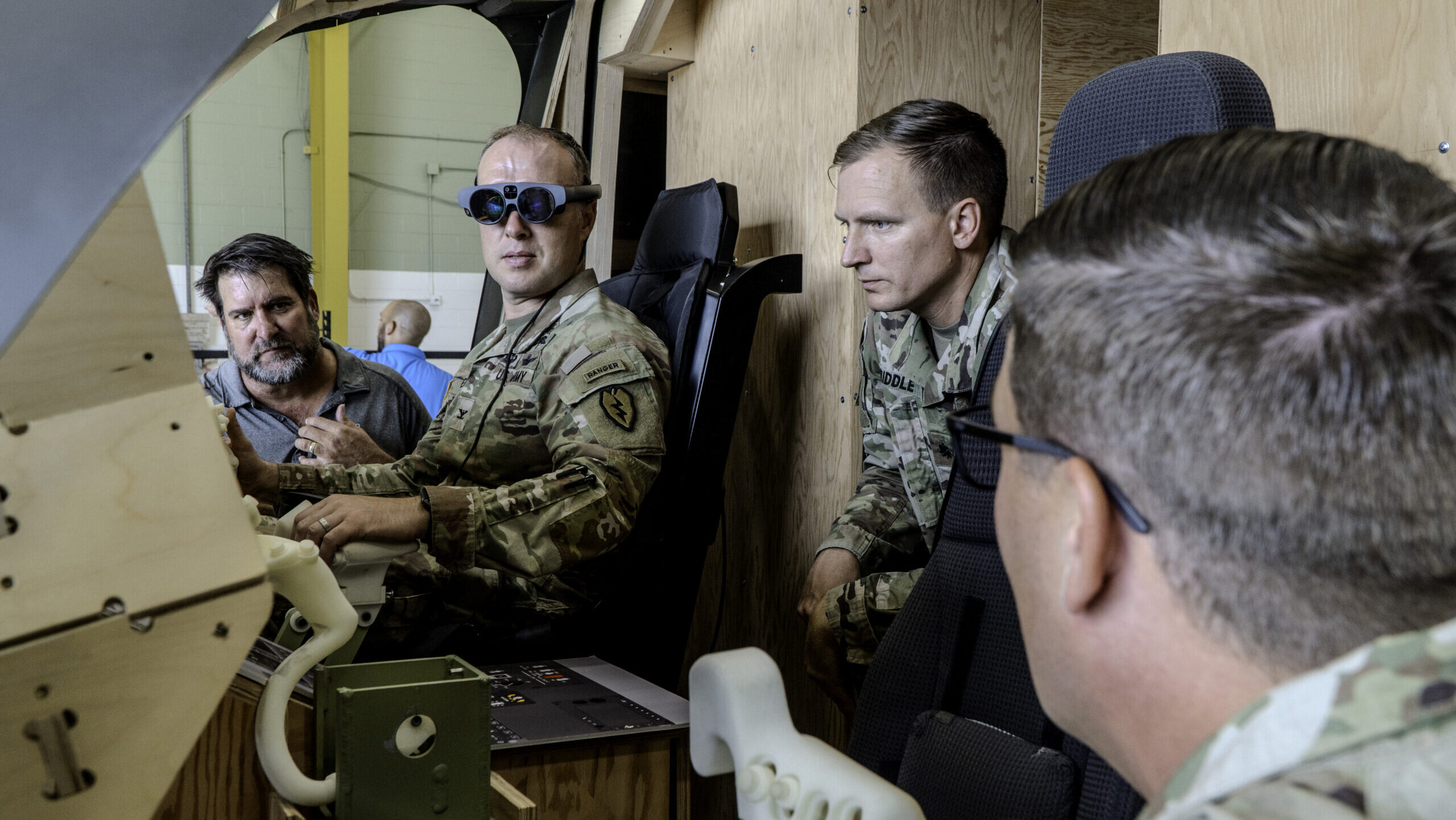Two British Army Special Operations Brigade soldiers, left, and a Soldier with the US Army 18th Space Company, 1st Space Brigade, right, guard a small tactical vehicle equipped with a miniaturized tactical space system during Project Convergence Capstone 4 experimentation at White Sands Missile Range, Feb. 28, 2024. (US Army photo by Brooke Nevins)
WASHINGTON — The Army could more than double the number of soldiers with expertise in space operations if top brass approves a proposal by Army Space and Missile Defense Command (SMDC) to implement the service’s new(ish) space vision, according to SMDC officials.
The idea is to create a new space-centered military occupational specialty, called “40D Space MOS,” that for the first time would include non-commissioned officers, Col. Mark Cobos, head of SMDC’s 1st Space Brigade, told Breaking Defense on the cusp of the annual Association of the US Army (AUSA) conference.
Right now, he explained, only about 500 commissioned officers have space specialities, with another 874 enlisted soldiers essentially being “borrowed” from other specialty units such as intelligence or air defense for short periods of three to four years. The new MOS is envisioned to initially include “upwards of 1,800 billets” for enlisted personnel by fiscal 2030. The plan also would bolster the officer corps up to some 800 by FY32.
SMDC is hoping for a decision from Army leadership by the end of October, Cobos added, although obviously the command hasn’t any authority on the timeline.
What’s The Army Doing In Space?
The Army long has had officers specializing in space under its F40 designation given that, as officials are always keen to point out, the service is the biggest military user of space capabilities. The new plan to pump up space personnel has two goals, SMDC officials explained.
First, more operators are needed to help the land service ensure that crucial satellite communications (SATCOM) and positioning, timing and navigation (PNT) capabilities are available during conflict. This includes, for example, acquiring commercial SATCOM services to augment limited military satellite access.
Second, and perhaps more importantly, trained soldiers are needed to run offensive operations against enemy satellite capabilities deep inside hostile territory. For example, this could include deploying small numbers of soldiers far forward with mobile jamming equipment.
Cobos noted that 1st Space Brigade soldiers already are starting to train in realistic environments where space operations are taking place “within hand grenade range” of enemy forces. In a recent exercise, he said, a 1st Space Brigade soldier “conducted a high altitude, low opening (HALO) tandem parachute jump with the 10th Special Forces Group at the National Training Center” to practice penetrating deep into enemy territory to conduct counterspace activities — though he did not provide details related to the secret squirrel-style exercise.
OP ED: The Army doth protest too much: In Space, jointness must come first
The two “principle bullets” in the “Army Space Vision Supporting Multidomain Operations [PDF]” published in January stipulate that the service needs to both “integrate” US space capabilities into its operations and “interdict” adversary space operations “simultaneously,” said Col. Donald Brooks, commandant of the Space and Missile Defense Center of Excellence in Colorado Springs, Colo.
“One of the Army’s core competencies is Joint Forcible Entry Operations, where an Army Task Force projects combat power deep in order to be able to establish the conditions so that follow-on Army forces can can move through that seized airfield or [other territory],” he told Breaking Defense. “And all of those Army core competencies, from a purely geometry standpoint, are what what you refer to as ‘behind those lines.’ We use terms like to be able to ‘penetrate,’ to be able to ‘isolate and disintegrate’ an adversary.”
Army Multi-Domain Operations includes space control activities, especially deep inside enemy territory. (Image: Army 4th Infantry Division)
“Disintegration” is a term of art defined in the Army’s Field Manual 3.0 [PDF] that establishes the service’s overarching doctrine; although it is not a term included in the capstone space doctrine governing joint force operations, Joint Publication 3-14. (Individual service doctrine feeds into joint doctrine, but joint doctrine in the end takes primacy over collective US military operations.)
“Disintegrate means to disrupt the enemy’s command and control, degrading the synchronization and cohesion of its operations. Disintegration prevents enemy unity of effort and leads to a degradation of the enemy’s capabilities or will to fight. It attacks the cohesion of enemy formations and their ability to employ combined arms approaches and work effectively together,” the Army manual explains.
EXCLUSIVE: New Joint Force space doctrine clarifies Space Command’s ‘offensive,’ ‘defensive’ ops
The stress on the concept’s application to space operations, according to Brooks and Cobos, is something relatively new in the Army Space Vision.
“The new part of it really is the requirement at tactical echelons for tactical organizations to be able to interdict an adversary’s use of space,” Cobos said.
Supporting Combatant Commands, Coordinating With Space Force
The personnel with the new 40 MOS designation would be integrated with a number of different Army units.
First, they would serve in the seven “space control planning teams” under the 1st Space Brigade, that work with the various regional combatant commands, Cobos said. Those planning teams already are embedded in “multiple theaters,” he said, and coordinate with Space Force components to provide the combatant commander with planning and “targeting” solutions — based on what capabilities are required for a specific task.
“That is exactly how we do fires across a whole bunch of things, from cruise missiles that come off of submarines or destroyers to the fires that the Army can bring and the fires that the Air Force can be able to service,” Cobos explained.
“Fires” is a military term signifying using weapons to create lethal and/or nonlethal effects on targets. Army officials have previously said that they only intend to take “non-kinetic” actions to disrupt, degrade or destroy adversary space systems, such as electromagnetic warfare and cyber operations.
OP ED: The Army has a vital role in space, and it continues to grow
So for space “fires,” Cobos said the Army can provide tactical capabilities for discreet, close-up-and-personal operations against enemy facilities or systems that perhaps the other services can’t.
A commander thus could decide that “instead of this really large system over right here that’s tethered — and it requires a lot of power and bandwidth and has a huge footprint and signal,” it was better to choose a “surgical tool” such as a “small force” that could get into the “extended deep” region of the battlefield “to be able to do this very small thing,” he said.
Space specialists also will make up a “space control company” under the new Theater Strike Effects Group (TSEG) pilot at Indo-Pacific Command. That TSEG, which is designed to undertake those interdiction operations, was approved along with the Army Space Vision. That pilot will achieve initial operating capability on Oct. 1, 2027, Cobos said.
“It will initially stand up with space control electronic warfare capabilities,” Brooks said. Over time, the TSEG will move on to “fielding and building the counter-surveillance and reconnaissance capabilities, high-altitude and [navigation war] formations as well.”
SMDC also hopes to soon be able to add a TSEG for European Command, following a month-long “experiment-slash-exercise” that he said has helped prove the unit’s value.
“I’m a little biased; I was the commander of the TSEG for that exercise, but I really do believe that we won over a lot of the leaders in EUCOM,” Brooks said.
Finally, the specialists also will support the Army’s Multi-Domain Task Forces, which each will have a space control company. The service has three such task forces and is “soon going to grow the fourth and fifth,” Brooks said.
“We’re very much complimentary to the Space Force and to the other services, but we truly do see space as that critical component to set the theater well in advance of phase one operations … when the first round is shot, the missile is shot, space needs to be there months, if not years, in advance to help set those conditions,” he said.











